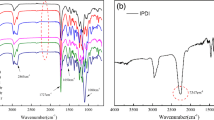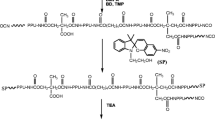Abstract
Non-polluting systems based on waterborne polyurethanes (wPU) and poly(urethane-urea)s (wPUU) were synthesized employing poly(propylene glycol) (PPG), dimethylolpropionic acid (DMPA) and 4,4′-dicyclohexylmethane diisocyanate (HMDI) as monomers. In the formulations, the length and the proportion of the soft segments were varied. Three types of chain extenders were employed: ethylene glycol (EG), producing urethane linkages; and ethylenediamine (EDA) and hydrazine (HYD), forming urea linkages. Cast films obtained from wPU and wPUU, monomers and prepolymers were analyzed by Fourier transform infrared spectrometry (FTIR). The profile of carbonyl absorption bands obtained for the films showed some remarkable differences depending on the formulation. The bands were split into two parts, which were directly related to the tendency of hydrogen bond formation. The length of soft segment, the amount of rigid portions and the presence of urea linkages showed a marked influence in both intensity and frequency absorption of the bands.
Similar content being viewed by others
References
Cocca M., D’arienzo L., D’orazio L., Gentile G. et al., Synthesis of poly(urethane urea) by in situ polymerization inside stone, J. Polym. Sci. Part B: Polym. Phys., 43: 542–552, 2005
Liu J., Ma D., Li Z., FTIR studies on the compatibility of hard-soft segments for polyurethane-imide copolymers with different soft segments, Eur. Polym. J., 38:661–665, 2002
Yilgör E., Yurtsever E., Yilgör I., Hydrogen bonding and polyurethane morphology. II. Spectroscopic, thermal and crystallization behavior of polyether blends with 1,3-dimethylurea and a model urethane compound, Polym., 43:6561–6568, 2002
Subramani S., Park Y. J., Lee Y. S., Kim J.-H., New development of polyurethane dispersion derived from blocked aromatic diisocyanate, Prog. Org. Coat., 48:71–79, 2003
Wang L., Shen Y., Lai X., Li Z., Liu M., Synthesis and properties of crosslinked waterborne polyurethane, J. Polym. Res. 18:469–476, 2011
Florian P., Kishore K., Allauddin J.S., Narayan R., et al., Preparation and characterization of waterborne hyperbranched polyurethane-urea and their hybrid coatings, Ind. Eng. Chem. Res., 49:4517–4527, 2010
Niu Z., Zhang X., Dai J., Zhang H., Investigation of ultraviolet curable waterborne polyurethane acrylate dispersion based on hydroxyl-terminated polybutadiene, Chem. China. 2:151–155, 2007
Bao L.-H., Lan Y.-J., Zhang S.-F., Synthesis and properties of waterborne polyurethane dispersions with ions in the soft segments, J. Polym. Res. 13:507, 2006
Coutinho F.M.B., Delpech M.C., Alves T.L., Ferreira A.A., Degradation profiles of cast films of polyurethane and poly(urethane-urea) aqueous dispersions based on hydroxy-terminated polybutadiene and different diisocyanates, Polym Deg Stab. 81:19–27, 2003
Coutinho F.M.B., Delpech M.C., Alves L.S., Anionic waterborne polyurethane dispersions based on hydroxyl terminated polybutadiene and poly(glycol propylene): synthesis and characterization, J. Appl. Polym. Sci., 80:566–572, 2001
Delpech M.C., Coutinho F.M.B., Waterborne anionic polyurethanes and poly(urethane-urea)s: influence of the chain extender on mechanical and adhesive properties, Polymer Test., 19:939–952, 2000
Coutinho F.M.B., Delpech M.C., Some properties of films cast from polyurethane aqueous dispersions of polyether-based anionomer extended with hydrazine, Polym. Test., 15:103–113, 1996
Wang C.B., Cooper S.L., Morphology and properties of segmented polyether polyurethaneureas, Macromol., 16:775–786, 1983
Yilgör E., Yilgör I., Yurtsever E., Hydrogen bonding and polyurethane morphology. I. Quantum mechanical calculations of hydrogen bond energies and vibrational spectroscopy of model compounds, Polymer, 43:6551–6559, 2002
Yang Ch.-Z., Hwang K. K.S., Cooper S. L., Morphology and properties of polybutadiene- and polyetherpolyurethane zwitterionomers, Makromol. Chem., 184:651–668, 1983
Yen F.-S., Hong J.-L., Hydrogen-bond interactions between ester and urethane linkages in small model compounds and polyurethanes, Macromol., 30:7927–7938, 1997
ASTM D 2572 Standard Test Method for Isocyanate Groups in Urethane Materials or Prepolymers, ASTM international, West Conshohocken, PA, 1979 (2010)
Coutinho F.M.B., Delpech M.C., Moura P.M.Q., Mello S.D.S., Synthesis and molecular weight determination of urethane-based anionomers, Polym. Bull., 37:1–5, 1996
Rahman M.M., Chun H.-H., Hyun Park H., Waterborne polysiloxane-urethane-urea for potential marine coatings, J. Coat. Technol. Res., 8:389–399, 2001
Goleneva L.M., Askadskii A.A., One-stage synthesis of network poly(urethane-isocyanurate) polymers, Polymer Science, 51:1278–1287, 2009
Yoo H.-J., Kim H.-D., Synthesis and properties of waterborne polyurethane hydrogels for wound healing dressings, J. Biomed. Mater. Res. Part B: Appl. Biomater., 85(B):326–333, 2007
El-Sayed A.A., El Gabry L.K., Allam O.G., Application of prepared waterborne polyurethane extended with chitosan to impart antibacterial properties to acrylic fabrics, J. Mater. Sci.: Mater. Med., 21:607–514, 2010
Silverstein R.M., Webster F.X., Kiemle D.J., Indentificação espectrométrica de compostos orgânicos, Livros Técnicos e Científicos Editora S.A., Rio de Janeiro, 2006
Yamagushi I., Takenaka Y., Osakada K., Yamamoto T., Synthesis and thermal properties of poly(urethane)s containing soft and flexible chain as the diols part, Polym. Bull., 41:29–35, 1998
Mahesh G.N., Philip T.G., Radhakrishnan G., Polyurethane telechelic cationomers containing end functional 4-vinylpyridinium moieties, Polym. Bull., 37:737–742, 1996
Mahesh G.N., Ramesh S., Radhakrishnam G., Segmented polyurethanes using fluorescein, J. Appl. Polym. Sci., 60:531–535, 1996
Ramesh S., Radhakrishnan G., Chain-extended polyurethane anionomers using ionic diols of varying methylene spacers, J. Polym. Sci. (A): Polym. Chem., 34:1713–1721, 1994
Micerva A., Zigon M., Malavasic T., Characterization and application of crosslinkers for polyurethane aqueous systems: Isopropylidene malonate-blocked isocyanurate, J. Appl. Polym. Sci., 54:2075–2081, 1994
Chen S.-A., Hsu J.-S., Polyurethane anionomers. I. Structure-property relationships, Polym., 34:2769–2775, 1993
Dillon J.G., Infrared spectroscopic atlas of polyurethanes. Technomic Publishing Company, Lancaster, 1989
Colthup N.B., Daly L.H., Wiberly S.E., Introduction to infrared and raman spectrometry, Academic Press, New York, 1975
Ishiara H., Kimura J., Saito K., Ono H., Infrared studies on segmented polyurethane-urea elastomers, J. Macrom. Sci. Phys., 10:591–618, 1974
Author information
Authors and Affiliations
Corresponding author
About this article
Cite this article
Delpech, M.C., Miranda, G.S. Waterborne polyurethanes: influence of chain extender in ftir spectra profiles. cent.eur.j.eng 2, 231–238 (2012). https://doi.org/10.2478/s13531-011-0060-3
Received:
Accepted:
Published:
Issue Date:
DOI: https://doi.org/10.2478/s13531-011-0060-3




